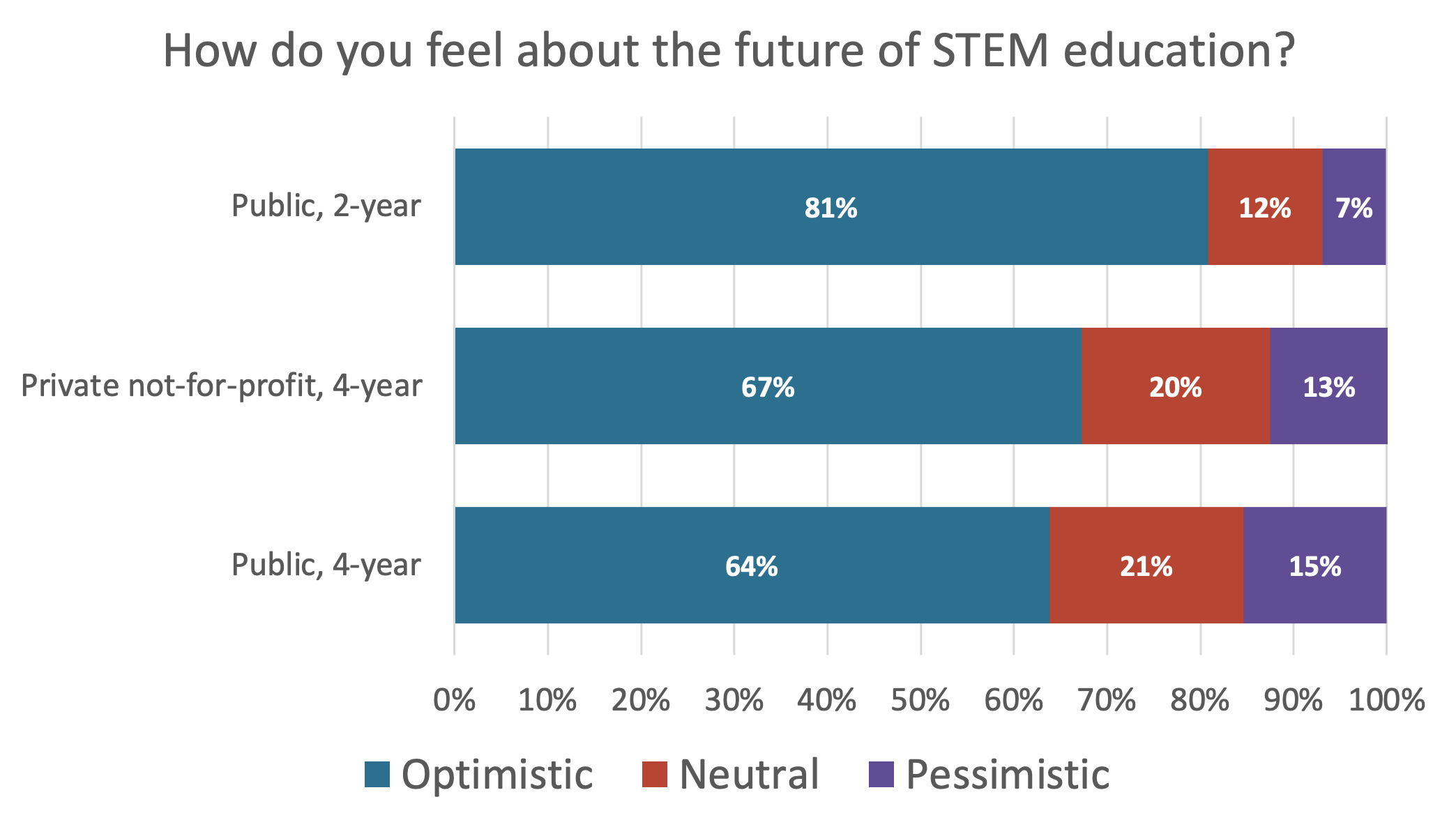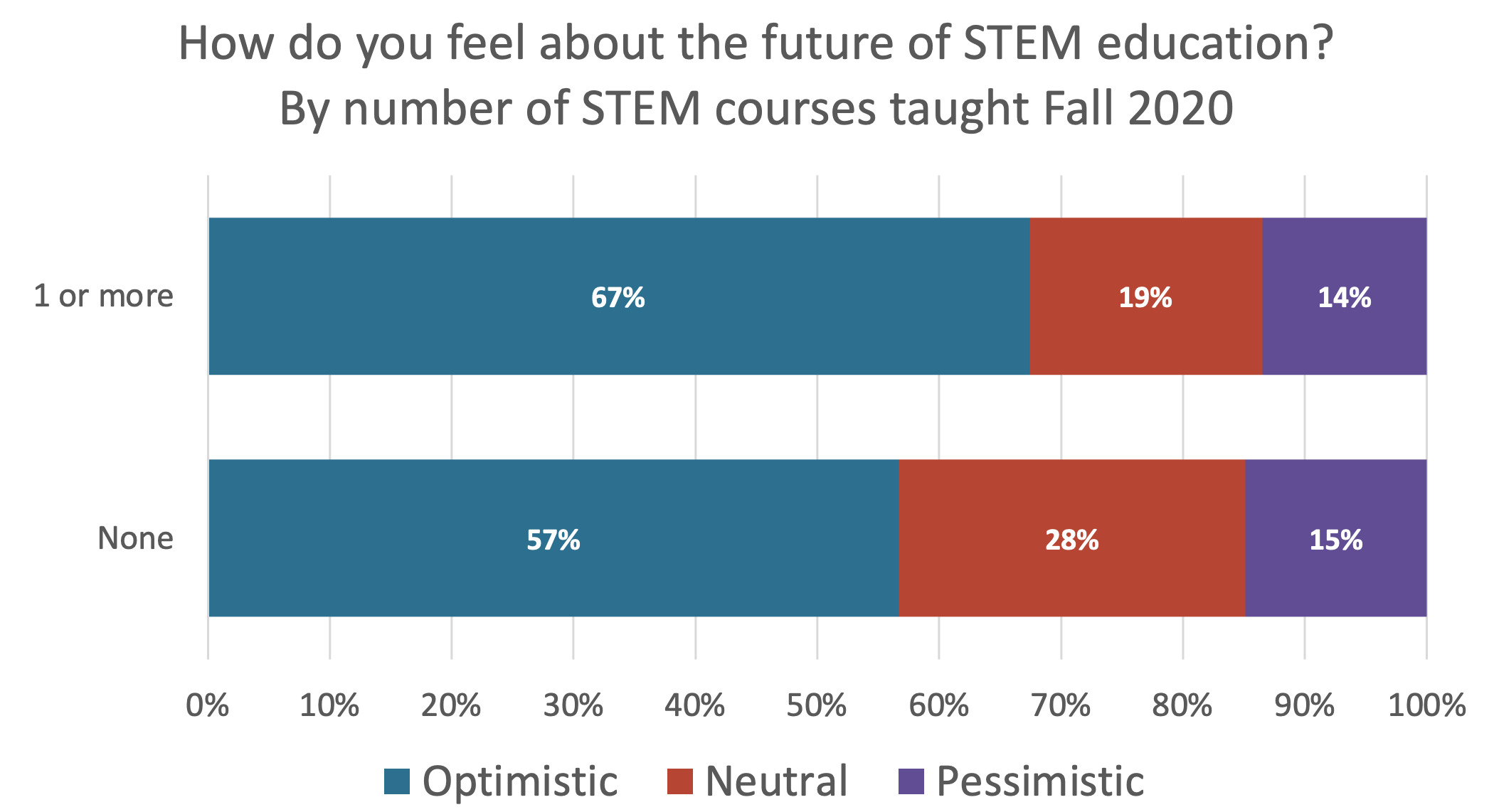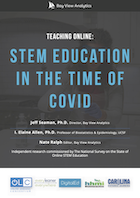Research Article:
Perceptions of the Future of STEM Education
Isabel Elaine Allen, Bay View AnalyticsA Fall 2020 survey of STEM faculty found differing levels of optimism for the future of post-secondary STEM education. The results show that, while the majority of all respondents are optimistic, some subgroups are significantly more optimistic about the future of post-secondary STEM education overall and are also more optimistic about their personal role in higher education in the future.
Overall, 66% of all respondents are optimistic about the future of STEM education at their own institution, and also optimistic about their personal role in higher education. The high level of optimism remains despite the decline in overall enrollment in colleges and universities by at least 3% from Fall 2019 to Fall 2020, according to preliminary federal data. Early data for 2021 shows an additional 3% drop (National Student Clearinghouse Research Center), with community college enrollment declining at least 15% by Fall 2020, and an additional 6% decline from Fall 2020 to Fall 2021.
Faculty at public and private 4-year institutions were less optimistic than their counterparts at public 2-year institutions. Contrasting declining enrollment rates in public 2-year colleges, 81% of faculty respondents are optimistic about the future of STEM education at their own college, and 75% are optimistic about their future in higher education. This contrasts with optimism about institutions at 4-year public and private institutions (64% and 67%, p=0.004 compared to 2-year colleges) and personal optimism (65% and 65%, p = 0.023 compared to 2-year colleges).
 A few other subgroups with differences were faculty teaching labs, and between male and female faculty. Unsurprisingly, faculty teaching courses with accompanying labs are much less optimistic about the future of STEM education at their institution (62% vs 69%, p = 0.039), and about their future in higher education (61% vs 69%, p = 0.008), as the survey found the largest barrier for teaching during the COVID-19 pandemic were labs. Male faculty are more optimistic about STEM at their institution (70%) than female faculty (75%, p = 0.017), but there are no differences by gender in faculty optimism about their personal roles in higher education (67% optimistic for both genders).
A few other subgroups with differences were faculty teaching labs, and between male and female faculty. Unsurprisingly, faculty teaching courses with accompanying labs are much less optimistic about the future of STEM education at their institution (62% vs 69%, p = 0.039), and about their future in higher education (61% vs 69%, p = 0.008), as the survey found the largest barrier for teaching during the COVID-19 pandemic were labs. Male faculty are more optimistic about STEM at their institution (70%) than female faculty (75%, p = 0.017), but there are no differences by gender in faculty optimism about their personal roles in higher education (67% optimistic for both genders). Faculty at minority serving institutions did not differ in their optimism for the future from other institutions (67% and 66%) and are slightly more optimistic about their personal future in higher education (68% vs 65%, p = 0.036). No differences are seen in faculty teaching online courses based on the number of online courses taught, but a large difference is seen if no online courses are taught vs any online courses (57% vs 68%, p = 0.006).
Faculty at minority serving institutions did not differ in their optimism for the future from other institutions (67% and 66%) and are slightly more optimistic about their personal future in higher education (68% vs 65%, p = 0.036). No differences are seen in faculty teaching online courses based on the number of online courses taught, but a large difference is seen if no online courses are taught vs any online courses (57% vs 68%, p = 0.006).In general, all faculty are all more optimistic than pessimistic about the future of STEM at their institution and their own future in higher education. When examined by type of institution, gender, and experience with online education, significant differences exist between groups. In addition, faculty teaching in courses with labs are more pessimistic about the future of online STEM education.
Download the full report: Teaching Online: STEM Education in the Time of COVID
More Information
More information about Bay View Analytics research in STEM can be found on our STEM Research page.Recent Publications
Digital Learning Pulse Surveys
- Infographic: 2023-2024 Digital Learning Pulse Survey
- The Digital Transformation of the Community College
- Planning for a Smaller Future: Dealing with Declining Enrollments
Course Material Affordability
- Pennsylvania Course Materials Survey 2023
- Pennsylvania Course Materials Presentation
- Course Material Webinar Slides
Open Educational Resources
- Digitally Established: Educational Resources in U.S. Higher Education, 2023
- Curricula of Many Sources: Educational Resources in U.S. K-12, 2023
- Research Brief: Digital and OER Textbook Adoption
- Research Brief: Faculty Satisfaction with Course Materials varies by Publisher
STEM
- Teaching Online: STEM Education in the Time of COVID
- What Makes a STEM Student
- Perceptions of the Future of STEM Education
Distance Education
- Digital Faculty: Faculty Social Media Use and Communications
- Infographic: Digital Faculty
- Grade Increase: Tracking Distance Education in the United States
Follow us on
Privacy
All survey respondents are provided complete anonymity. No personally identifiable information is released. Full privacy policy.
